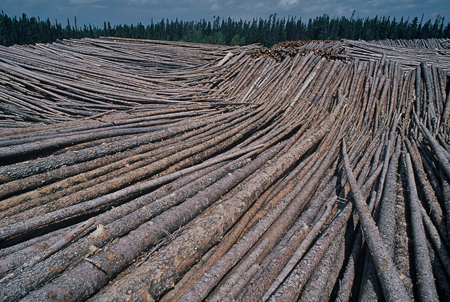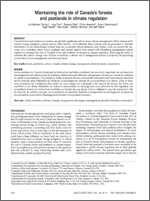
Intact natural forests are vital to climate regulation.
Credit: Garth Lenz
Until quite recently, a major factor increasing global warming problems had been largely ignored in the debates and discussions around climate change and what to do about it.
Emissions from land-use change, which mainly come from industrial development such as logging, mining, peat extraction and draining, and others, are estimated to be nearly 20% of all greenhouse gas emissions from human-related causes. This is about the same as (if not more than) the world’s entire transportation sector, which includes all cars, trucks, planes, and shipping.

Land-use activities like logging can have a major impact on global warming.
Credit: Garth Lenz
In 2007 I attended a workshop titled “The Role of Canadian Boreal Ecosystems in Climate Regulation” with notable experts from a variety of fields to discuss the role Canada’s boreal forest has in climate regulation. Boreal forests and soils have both the highest density and overall net storage of terrestrial carbon anywhere on the planet (see our report on carbon in boreal forests), meaning they play an extremely important role in mitigating climate change. It also means, however, that they are highly susceptible to releasing large quantities of greenhouse gases into the atmosphere when developed.
From this workshop a paper was written providing an overview and recommendations for land use management in Canada’s vast expanses of boreal forest and peatlands. While much of Canada’s boreal is still intact, development has hit the southern boreal extensively and pushes further north every year.
Our paper was recently published in the Forestry Chronicle, a leading peer-reviewed journal on forestry practices and management. It’s titled “Maintaining the role of Canada’s forests and peatlands in climate regulation” and is now downloadable as a PDF.
Click on the thumbnail or here to download the paper.
Here is a summary of some of the key recommendations we made for industry and government regarding their practices in Canada’s forests and peatlands:
- Reduce deforestation and increase afforestation
- Avoid logging of natural forests
- Employ forest management practices that enhance carbon storage:
- extend rotation periods between harvests to increase average age of forests across landscape
- reduce soil disturbance and maintain coarse woody debris
- Employ forest sector practices to enhance carbon storage and minimize greenhouse gas emissions:
- capture methane emissions from forest products at landfills
- increase recycling and switch production to longer lived forest products
- use energy in wood waste for power production
- Minimize the extraction of peat soils
- Minimize soil disturbance
- minimize ground disturbance in areas with saturated soils
- avoid disturbance to permafrost
The participants in the workshop were: Mathew Carlson (Canadian Boreal Initiative), Jing Chen (University of Toronto), Stewart Elgie (University of Ottawa), Chris Henschel (CPAWS), Werner Kurz (Canadian Forest Service), Alvaro Montenegro (University of Victoria), Nigel Roulet (McGill University), Neal Scott (Queen's University), Charles Tarnocai (Agriculture and Agri-Food Canada), and Jeff Wells (International Boreal Conservation Campaign).


